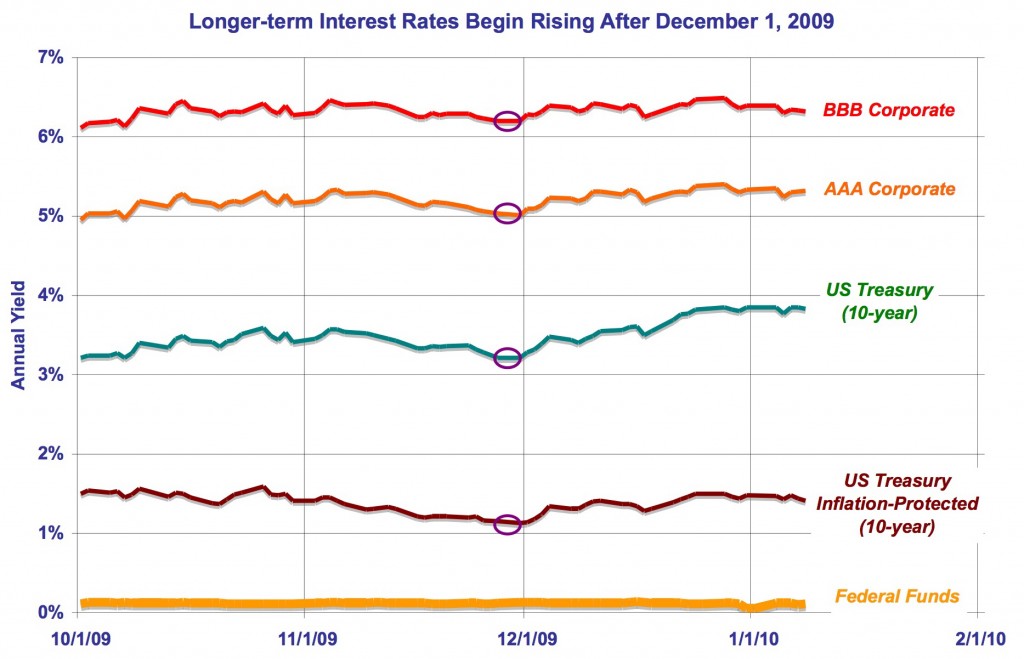Long-term Interest Rates Break the Fed’s Hold – Short-term Next?
 Central banks usually have control over short-term interest rates. However, their efforts can fall flat when they try to influence long-term ones. This time is no different. The Federal Reserve has been buying US government bonds and mortgage securities, trying to hold down yields. After a period of “success”, the Fed is once again seeing the independent bond market take off in the opposite direction.
Central banks usually have control over short-term interest rates. However, their efforts can fall flat when they try to influence long-term ones. This time is no different. The Federal Reserve has been buying US government bonds and mortgage securities, trying to hold down yields. After a period of “success”, the Fed is once again seeing the independent bond market take off in the opposite direction.
A central bank has two key monetary roles that they normally carry out well:
- Controlling the money supply in conjunction with short-term interest rates
- Serving as the lender of last resort – the supplier of funds in adverse times when no other sources are available
The Federal Reserve actively managed these direct roles throughout our recent problem period. They boosted money availability and dropped short-term rates to near zero. And they provided the financial system with ready access to emergency funding.
However, they then decided to tackle economic growth, employment, housing and long-term rates. The problem is that all four are governed mainly by influences outside of the Fed’s control.
For example, bond investors are reacting to three factors: large bond offerings (supply) coming in the near future, improving economic growth and increasing inflation forecasts. The approaching start of short-term rates rising is also weighing on the market. As a result, in spite of the Fed’s efforts, bond rates have been rising since December 1, as shown below:

So, will these long-term yield increases affect short-term rates? I believe so, because they have put the Federal Reserve in a box.
If the Fed continues to keep short rates low as bond yields rise, they are essentially subsidizing a windfall for those that can borrow short and invest (or lend) long – i.e., the banks. Also, the Federal Reserve Board members will be hard pressed to argue that their view of the economy (fragile) and inflation (benign) is accurate when the bond market is saying the opposite. Historically, this is a highly flammable combination that can burst into excess growth, borrowing and inflation (AKA “bubble”).
There are two other points that, to me, indicate the long-term rate rise will produce a lifting of the Federal Reserve’s current approach:
First, regardless of the direction of long rates, short rates are abnormally low and are destined to rise as soon as the Fed decides to stop providing “easy” money.
Second, the Fed has just “warned” banks to prepare for reduced interest rate spreads, meaning the short-term rates could start rising faster than long-term ones.
So, what does all this mean to us investors?
When the Fed allows short-term rates to begin moving back to normal levels, short-term investments will once again start producing attractive returns. We will be able to buy US Treasury bills, certificates of deposit, commercial paper, money market funds and even time deposits with reasonable yields.
Meanwhile, I continue to think long-term bonds are an investment to avoid. Yes, bond prices have fallen as longer-term rates have risen. But a short-rate rise could exacerbate the trend. The investor bond demand that has been driven by low short-term rates could diminish and, in the face of declining bond prices, could even reverse. And just wait until investors want to own stocks again…




